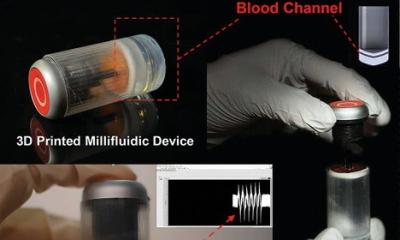Optoelectronic sensor detects white coat hypertension and blood pressure variability
Tarilian Laser Technologies (TLT) have confirmed, from early studies, the ability of its Sapphire sensor technology to detect white coat hypertension (WCH) during measurement of blood pressure in a clinical setting and to create a novel platform from which WCH can be distinguished from background stress and anomalous baseline variability.

White coat hypertension, which is commonly called white coat syndrome, is the term used to describe the raised blood pressure shown by patients when their blood pressure is measured in a clinical setting that is not shown elsewhere, such as at home. This raised pressure is significant for medical diagnosis as it may lead to inappropriate management of the hypertensive patient — which increases risk, distress and costs to the healthcare system.
Commenting on this new discovery, Dr Sandeep Shah, CEO of TLT stated: “Yet again we are uncovering new capabilities of our optoelectronic blood pressure sensor and the very rich signal that it generates. This new pivotal development further distinguishes the TLT technology from other technologies on the market in that we can further validate potential false positives within the clinical process and avoid the situation where the patient receives unnecessary treatments.”
Variability in baseline blood pressure
Blood pressure can sometimes fluctuate in humans as a result of a complex interactions between external stimuli and the response of cardiovascular control mechanisms in the body. This is now suspected to be an important factor to measure and where possible to try and control. Blood pressure variability is mainly detected using 24-hour ambulatory blood pressure monitoring – ie using cumbersome and often inaccurate oscillometric measurements.
The TLT Sapphire sensor now offers a new powerful dynamic in that it can accurately and directly determine beat-to-beat blood pressure using an optical microsensor that is very small, innocuous and comfortable to wear, avoiding the discomfort of the current systems.
Until a few years ago, the variability in blood pressure had been dismissed as a 'background noise' that dilutes the prognostic effects of average blood pressure. Recent research now indicates that blood pressure variability is in itself an important phenomenon to track and control as it is associated with morbidity and mortality.
Blood pressure variability is an important risk factor for stroke and this is substantiated by evidence from various clinical trials around the world. Systolic blood pressure varies to a greater degree than diastolic blood pressure. Early death or neurologic deterioration, and recurrent stroke are associated independently with high systolic blood pressure, mean arterial pressure, pulse pressure, and blood pressure variability.
Commenting on this new development, TLT CEO Dr Sandeep Shah stated: “ At TLT, we are excited by the further progression of our understanding of how the TLT Sapphire waveform — which with its high fidelity and rich data — can give a better and more accurate assessment of blood pressure variability. Blood pressure variability is something that has become a key topic for discussion at several major international medical conferences. Having the robust non-invasive TLT sensor that can directly monitor beat-to-beat blood pressure variability allows us to uncover even more useful information that will help us to protect the patient further. Within the next few weeks, we now expect to develop a new Sapphire sensor platform focussed on detailed beat-to-beat analysis and thus open up a paradigm for the utility of the TLT sensor around the world.”
30.01.2012











